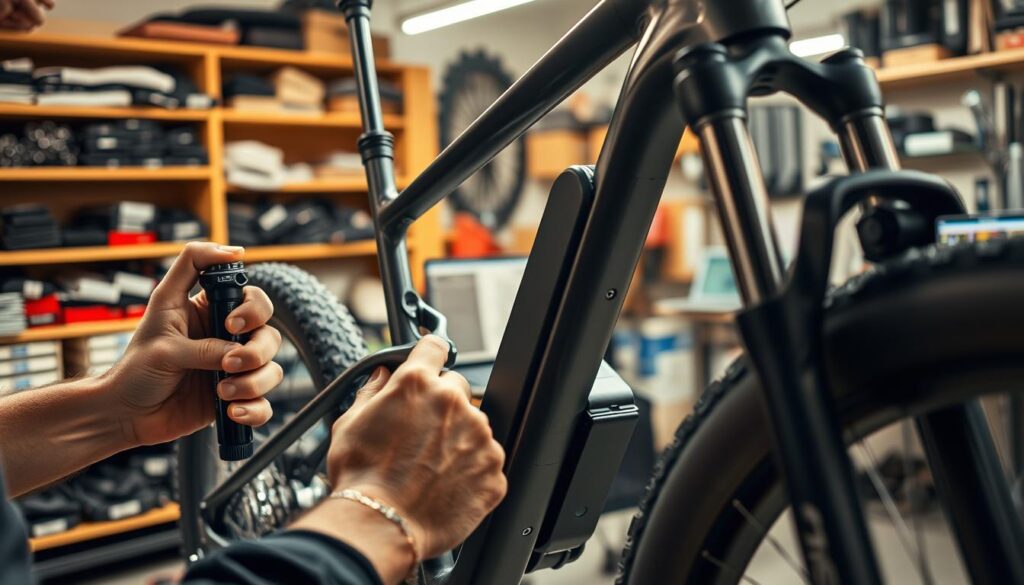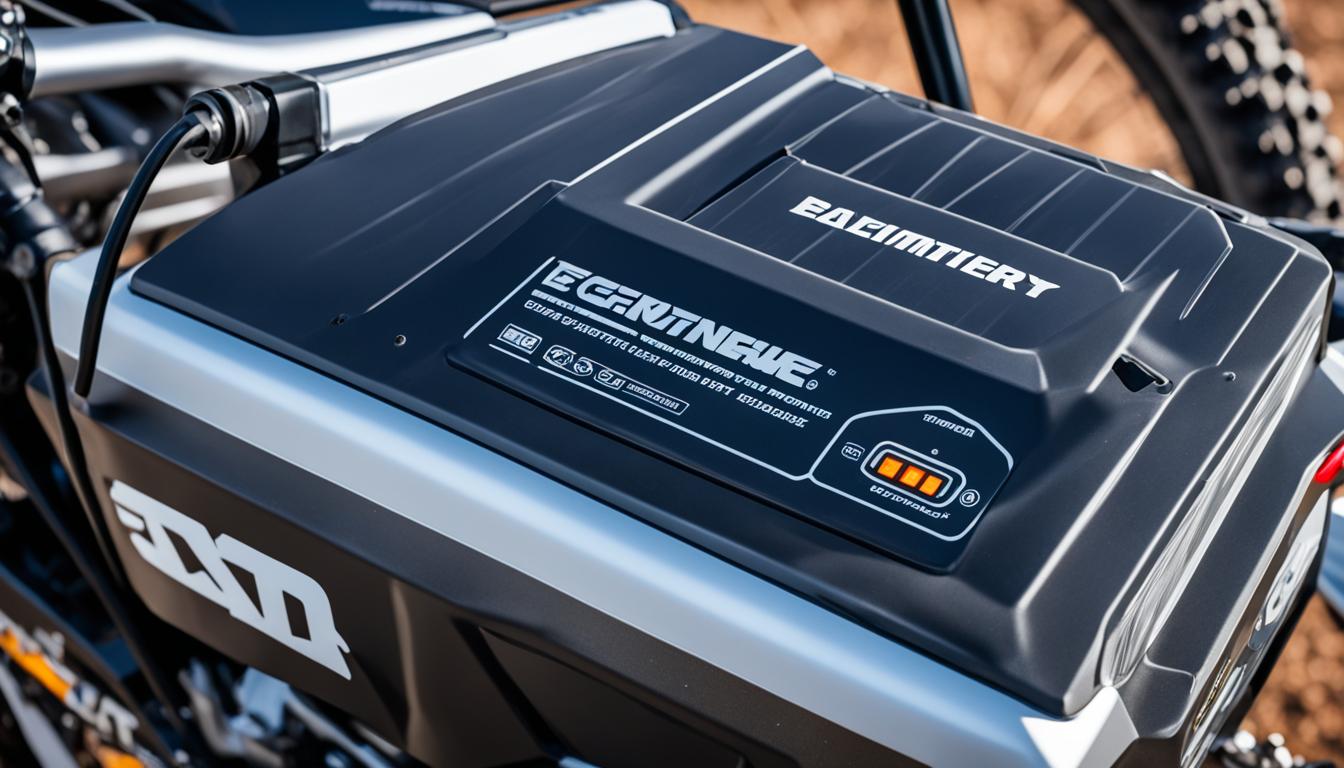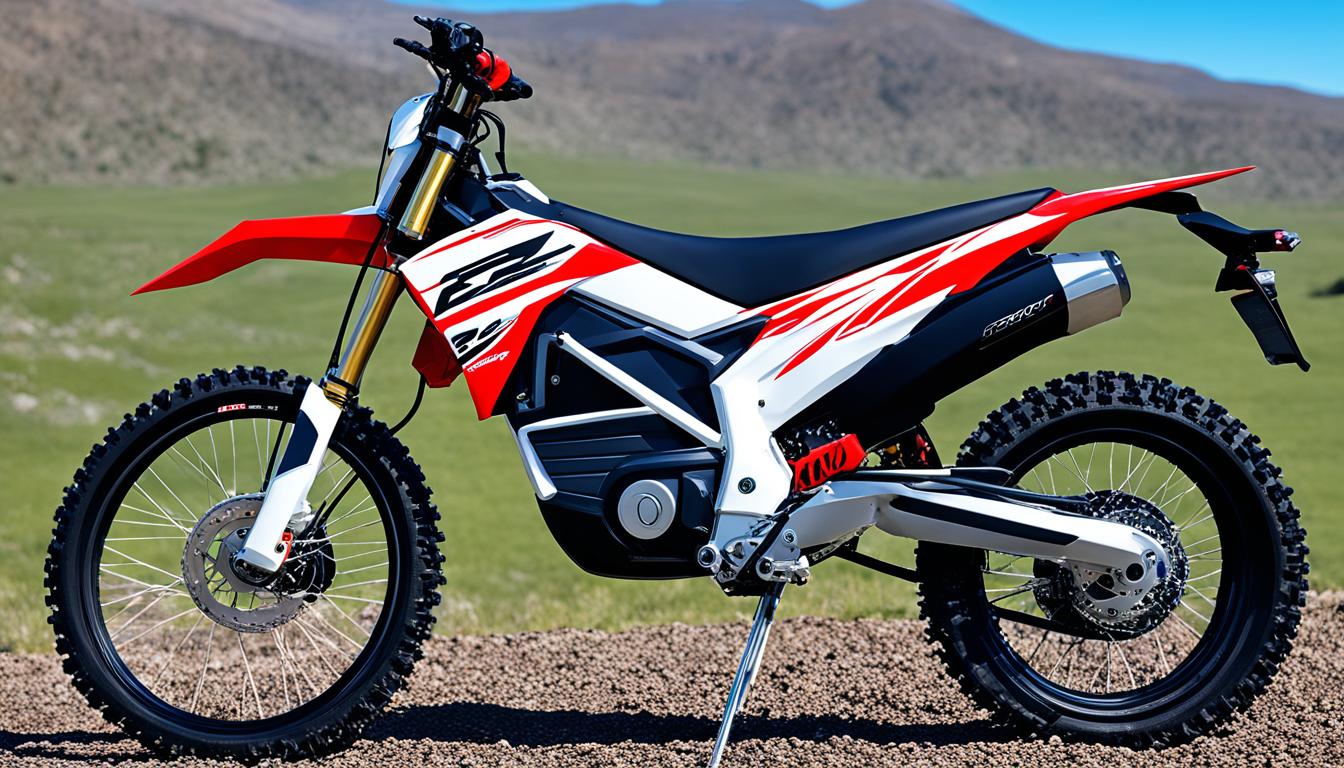Have you ever felt the jarring impact of a bumpy road while riding your electric bike? It’s not just uncomfortable—it can also affect your control and safety. The key to a smoother, more enjoyable ride lies in the suspension system, a critical component that absorbs shocks and vibrations. Whether you’re cruising through city streets or tackling rough terrain, keeping your front fork and other parts in top shape ensures better performance and comfort.
Regular checks on components like stanchions and sliders are essential to prevent issues like leaks or wear. Cleaning, lubricating, and adjusting air pressure can make a significant difference in how your bike handles. Ignoring these steps can lead to damage, reducing the lifespan of your suspension system and compromising your ride quality1.
This guide will walk you through the basics of keeping your electric bike in peak condition. From troubleshooting common problems to advanced tuning techniques, you’ll learn how to enhance your riding experience while ensuring safety. After all, a well-maintained bike isn’t just about comfort—it’s about enjoying every mile with confidence.
Understanding E-Bike Suspension Systems
What makes your e-bike glide effortlessly over bumps and potholes? The answer lies in its suspension system. This critical component absorbs shocks, ensuring a smoother and more controlled ride. Whether you’re navigating city streets or tackling rugged trails, understanding how your bike’s suspension works can enhance your riding experience.
Exploring Front, Rear, and Full Suspension Setups
There are three primary types of suspension systems: front, rear, and full. Each setup offers unique benefits depending on your riding style and terrain.
- Front Suspension: This setup features a fork that absorbs impacts on the front wheel. It’s ideal for light off-road riding and provides a balance of cost and performance2.
- Rear Suspension: Found on the back wheel, this system improves traction and comfort on rough terrain. It’s perfect for riders who frequently explore challenging paths3.
- Full Suspension: Combining both front and rear systems, full suspension offers maximum comfort and control. It’s the go-to choice for advanced riders tackling tough trails4.
How Suspension Components Work Together
At the heart of every suspension system are the spring and damper. The spring, whether coil or air-based, compresses to absorb shocks. The damper controls the rebound, ensuring a smooth return to the original position. Together, these components work seamlessly to provide stability and comfort.
“A well-tuned suspension system not only enhances ride quality but also extends the lifespan of your bike’s components.”
| Type | Best For | Pros | Cons |
|---|---|---|---|
| Front Suspension | Light off-road, city riding | Affordable, lightweight | Limited shock absorption |
| Rear Suspension | Rough terrain, off-road | Improved traction, comfort | Heavier, more expensive |
| Full Suspension | Challenging trails, advanced riders | Maximum control, comfort | Costly, heavier |
Understanding these components is crucial for proper care and troubleshooting. Regular checks on parts like stanchions and sliders can prevent issues like leaks or wear, ensuring your bike performs at its best2.
Essential EV Bike Suspension Maintenance Practices
Regular care of your e-bike’s suspension ensures a smoother and safer ride. By keeping components like the fork and shock absorbers in top condition, you can avoid issues that compromise performance and safety5.
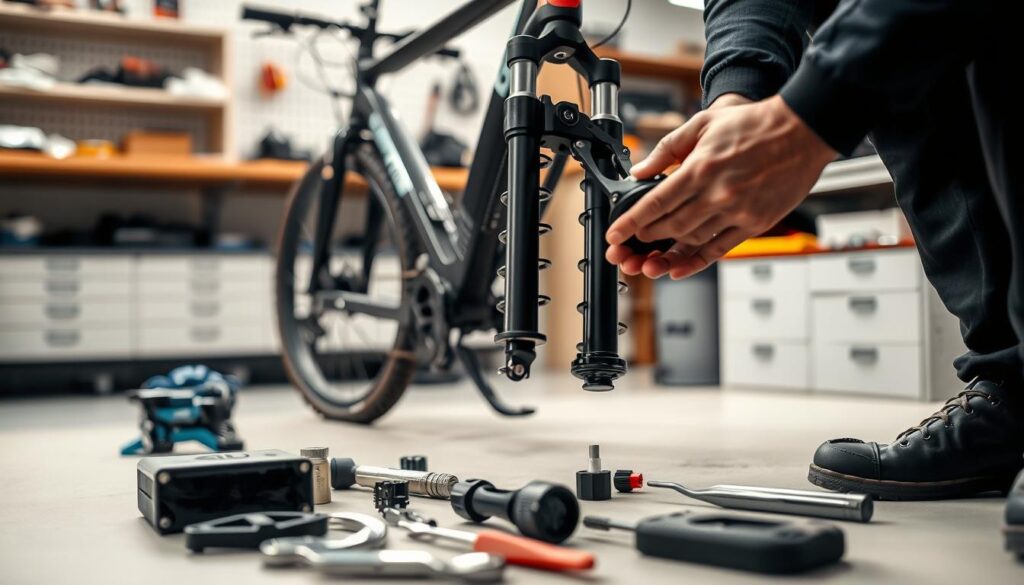
Why Regular Maintenance Enhances Safety and Comfort
Scheduled upkeep is a critical safety measure for electric bikes. Routine checks on oil levels, air pressure, and lubrication prevent wear and tear, ensuring your bike handles bumps and rough terrains effectively6.
Addressing issues like squeaks, leaks, and bottoming out promptly can prevent costly repairs. For example, low air pressure in air springs can reduce shock absorption, while worn-out coil springs may need replacement5.
Key Benefits of Timely Service and Adjustments
Timely service leads to enhanced overall ride comfort. Maintaining correct suspension settings based on terrain and usage ensures better control and stability6.
Regular inspections also offer peace of mind for riders on varied road conditions. By identifying minor issues early, you can avoid major repairs and extend the lifespan of your bike’s components5.
| Maintenance Task | Benefit |
|---|---|
| Cleaning stanchions | Prevents scratches and maintains performance |
| Checking air pressure | Ensures optimal shock absorption |
| Lubricating moving parts | Reduces friction and wear |
| Inspecting seals for leaks | Prevents hydraulic damper issues |
By following these practices, you can enjoy a smoother, safer, and more enjoyable ride every time you hit the road6.
Identifying Common Suspension Issues and Troubleshooting
Is your ride feeling rougher than usual? It might be time to check your suspension. Over time, components like the fork and shock absorbers can develop issues that affect performance and comfort. Recognizing these problems early can save you from costly repairs and ensure a smoother experience on the road7.
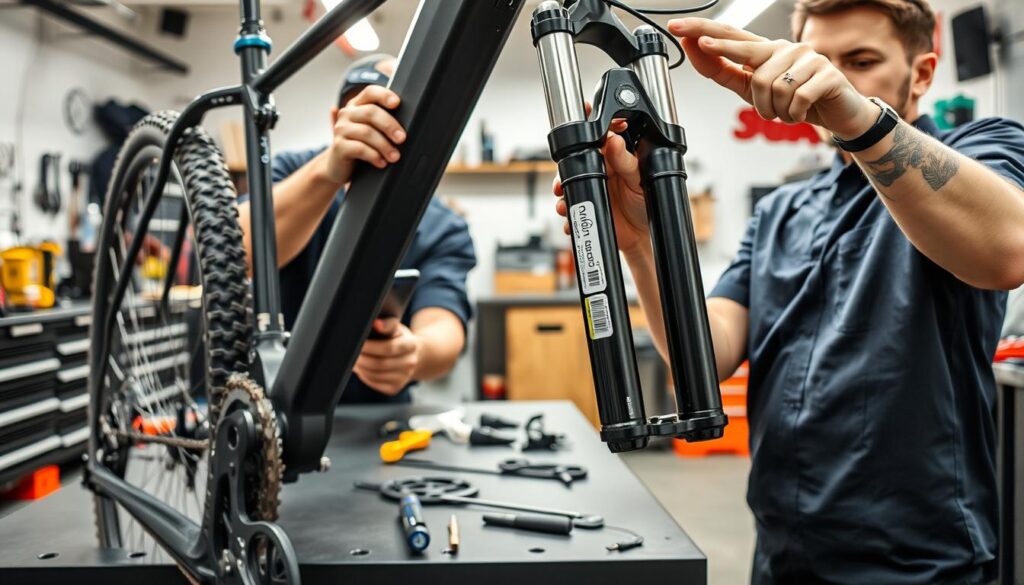
Recognizing Squeaking, Leaks, and Bottoming Out
Squeaking noises often indicate a lack of lubrication or worn-out seals. Persistent leaks, whether oil or air, can compromise the suspension system’s ability to absorb shocks. Bottoming out, where the fork or shock fully compresses on bumps, signals the need for adjustments in air pressure or spring tension8.
For example, a fork that creaks might simply need fresh oil, while low air pressure can reduce shock absorption. Regular inspections of seals and lubrication points can prevent these issues from escalating7.
Effective Solutions for Deteriorating Performance
Timely troubleshooting is key to maintaining optimal performance. Start by inspecting seals for wear and applying proper lubrication to moving parts. Adjusting air pressure or preload settings can restore comfort and control, especially for riders tackling varied terrains8.
Here’s a quick guide to addressing common suspension problems:
| Issue | Solution |
|---|---|
| Squeaking noises | Apply lubrication to moving parts |
| Oil or air leaks | Inspect and replace worn seals |
| Bottoming out | Adjust air pressure or spring tension |
By addressing these issues promptly, you can extend the life of your suspension components and enjoy a safer, more comfortable ride7.
Step-by-Step Guide to Suspension Cleaning and Lubrication
Keeping your e-bike’s suspension clean and well-lubricated is key to maintaining a smooth and safe ride. Dirt and grime can accumulate over time, affecting performance and causing premature wear. Regular cleaning and lubrication not only enhance comfort but also extend the life of your components9.
Proper Techniques for Cleaning Stanchions and Forks
Start by wiping down the stanchions and fork with a soft, lint-free cloth. Avoid using harsh chemicals or abrasive materials that could damage the seals. For stubborn dirt, a gentle rinse with water is effective, but keep pressure washers away to prevent seal damage10.
Here’s a quick checklist for cleaning:
- Wipe stanchions with a soft cloth to remove surface dirt.
- Rinse gently with water, avoiding direct contact with seals.
- Dry thoroughly to prevent moisture buildup.
Regular cleaning prevents dirt buildup, ensuring your suspension system operates smoothly9.
How to Lubricate and Adjust Suspension Settings
After cleaning, apply a high-quality suspension oil to moving parts. Use a small amount and allow time for the oil to penetrate. Over-lubrication can attract dirt, so moderation is key10.
Adjusting settings like air pressure or preload ensures optimal performance. Check the manufacturer’s recommendations for your specific model. Proper adjustments improve control and comfort, especially on varied terrain9.
By following these steps, you’ll keep your e-bike’s suspension in top condition, ensuring a safer and more enjoyable ride10.
Advanced Suspension Tuning for Varied Terrain
Mastering advanced tuning techniques can transform your ride across any terrain. Whether you’re navigating city streets or tackling rugged trails, optimizing your setup ensures better control and comfort. Advanced tuning involves adjusting key settings like sag, preload, and air pressure to match your weight and riding style11.
Adjusting Air Pressure, Preload, and Sag for Optimal Control
Sag is the amount your suspension compresses under your weight. For optimal performance, aim for 20% sag in the fork and 30% in the shock11. Use a shock pump to adjust air pressure in 5 psi increments for the fork and 10 psi for the shock. Preload, which adjusts spring tension, ensures your suspension responds effectively to bumps and drops.
Here’s a quick guide to measuring sag:
- Measure the total shock stroke (e.g., 50 mm).
- Calculate sag: (15 mm of sag / 50 mm total stroke) x 100 = 30% sag11.
Fine-Tuning Fork Settings for Different Riding Conditions
For city riding, reduce air pressure slightly for a smoother experience. On rough terrain, increase pressure for better support and control. Adjusting rebound and compression damping can further enhance performance. Start with low-speed compression fully open and increase by two clicks at a time11.
“Balanced suspension setup ensures both front and rear feel supportive, improving overall ride quality.”
By tailoring your settings to the terrain and your weight, you’ll not only improve control but also extend the life of your components. Advanced tuning is the key to unlocking the full potential of your ride12.
Maintenance Intervals and Regular Service Tips
Maintaining your e-bike’s performance starts with a consistent inspection routine. Regular checks ensure your fork and other components stay in top shape, preventing wear and damage. Whether you ride daily or occasionally, a well-planned schedule maximizes safety and comfort13.
Establishing a Routine Inspection Schedule
For intense riders, inspect parts every 100 miles and schedule a tune-up every 300 miles. A full overhaul is recommended every 1,000 miles13. Moderate riders can extend these intervals to 150 miles for inspections and 1,200 miles for overhauls. Occasional riders may check parts every 200 miles and overhaul every 1,500 miles13.
Quick post-ride checks are essential, especially after dusty or rough rides. Look for leaks, worn seals, or unusual noises. These small steps can prevent bigger issues down the road14.
“A well-maintained e-bike not only performs better but also ensures a safer ride for the rider.”
Professional Servicing and Maintenance Logs
While DIY checks are helpful, professional servicing is crucial for complex issues. Schedule a tune-up at least once a year, especially if you ride frequently14. Keeping a maintenance log helps track service intervals and identify patterns in wear or damage. This practice ensures timely interventions and extends the lifespan of your suspension system.
| Riding Frequency | Inspection Interval | Tune-Up Interval | Full Overhaul |
|---|---|---|---|
| Intense | Every 100 miles | Every 300 miles | Every 1,000 miles |
| Moderate | Every 150 miles | Every 300 miles | Every 1,200 miles |
| Occasional | Every 200 miles | Every 300 miles | Every 1,500 miles |
By following these guidelines, you’ll keep your e-bike in peak condition, ensuring a smooth and safe ride every time13.
Conclusion
Taking care of your ride’s components ensures a smoother journey every time. Understanding how your system works is the first step to maintaining peak performance. Regular cleaning, lubrication, and air pressure checks keep your fork and other parts in top shape15.
Advanced tuning techniques, like adjusting spring tension, can tailor your setup for different terrains. These adjustments improve control and comfort, making every ride more enjoyable16.
Consistent care not only enhances performance but also extends the life of your components. By following these tips, you’ll ensure a safer and more reliable experience on the road.
Source Links
- How to Maintain Your E-Bike’s Suspension Front Fork for a Smooth Ride
- A Comprehensive Guide To Electric Bike Suspension
- Everything You Need to Know About Electric Bike Suspension
- A Comprehensive Guide on Suspension System | Ebike School Vol.2
- E-Bike Suspension: A Comprehensive Guide to a Smoother Ride
- Perfecting E-Bike Suspension: A Comprehensive Guide
- The Ultimate E-Bike Troubleshooting Guide: Solving Common Electric Bicycle Problems
- Electric Bike Troubleshooting 101: Tips, Tricks & Safety Precautions
- A Comprehensive Guide to Maintaining the Rear Suspension of a Full-Suspension Mountain eBike for Long-Lasting Optimal Performance
- How to Clean and Maintain Your Electric Dirt Bike: A Step-by-Step Guide
- Setup Guide – How to adjust your mountain bike suspension for optimal performance
- E-Bike Suspension 101: Everything You Need to Know
- How Often To Service Your E-bike
- Velotric’s Essential E-Bike Maintenance Guide
- How to Maintain Your E-Bike’s Suspension Front Fork for a Smooth Ride
- A Comprehensive Guide to Maintaining the Rear Suspension of a Full-Suspension Mountain eBike for Long-Lasting Optimal Performance
